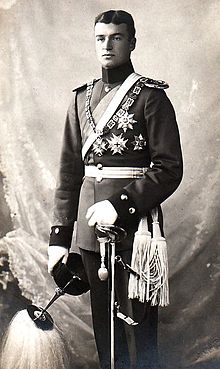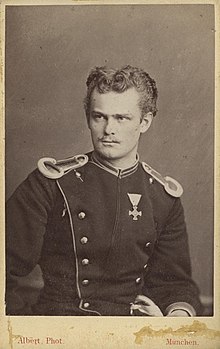Duke Siegfried August in Bavaria: Difference between revisions
No edit summary |
AdamLeyton (talk | contribs) No edit summary |
||
| Line 30: | Line 30: | ||
Two months later the engagement was broken off by the Archduchess, owing to her sudden discovery of the stormy antecedents of her fiancé, which she had ignored at the time when she promised to become his wife. The breaking off of the engagement was a matter which was arranged between the young people themselves, and that they had been deeply in love with each other was shown by the appeal immediately afterward by the Archduchess to the Emperor for permission to enter Holy Orders and to take the vows of a Benedictine nun, while the Duke became a prey to melancholia, which in course of time has developed into insanity, rendering his confinement now necessary. |
Two months later the engagement was broken off by the Archduchess, owing to her sudden discovery of the stormy antecedents of her fiancé, which she had ignored at the time when she promised to become his wife. The breaking off of the engagement was a matter which was arranged between the young people themselves, and that they had been deeply in love with each other was shown by the appeal immediately afterward by the Archduchess to the Emperor for permission to enter Holy Orders and to take the vows of a Benedictine nun, while the Duke became a prey to melancholia, which in course of time has developed into insanity, rendering his confinement now necessary. |
||
[[File:Max Emanuel in Bayern1.jpg|left|thumb|Father Siegfried, Duke Max Emanuel in Bayern]] |
[[File:Max Emanuel in Bayern1.jpg|left|thumb|Father Siegfried, [[Duke Maximilian Emanuel in Bavaria|Duke Max Emanuel in Bayern]]]] |
||
== Melancholy == |
== Melancholy == |
||
It may be remembered that the origins of the insanity of the Duke’s cousin, the crazy King [[Otto of Bavaria]], was due to unfortunate love affair which he took too deeply to heart, and that the first blow to the reason of the late King [[Ludwig II of Bavaria]] was given by the Court intrigue which brought about the breaking off of his engagement to his cousin, [[Duchess Sophie Charlotte in Bavaria]], on the eve of the date appointed for the wedding. King Ludwig, after being placed under restraint as a lunatic, died a violent death in the waters of Lake Starnberg in 1886, while his former fiancée, after a far from happy marriage with the French Duke of Alencon, perished in the flames of the charity bazaar conflagration at Paris some years ago. |
It may be remembered that the origins of the insanity of the Duke’s cousin, the crazy King [[Otto of Bavaria]], was due to unfortunate love affair which he took too deeply to heart, and that the first blow to the reason of the late King [[Ludwig II of Bavaria]] was given by the Court intrigue which brought about the breaking off of his engagement to his cousin, [[Duchess Sophie Charlotte in Bavaria]], on the eve of the date appointed for the wedding. King Ludwig, after being placed under restraint as a lunatic, died a violent death in the waters of Lake Starnberg in 1886, while his former fiancée, after a far from happy marriage with the French Duke of Alencon, perished in the flames of the charity bazaar conflagration at Paris some years ago. |
||
Revision as of 20:10, 4 April 2013
| Duke Siegfried August | |||||
|---|---|---|---|---|---|
| Duke Siegfried August in Bavaria | |||||
 | |||||
| Born | 10 July 1876 Bamberg, Kingdom of Bavaria | ||||
| Died | 12 March 1952 (aged 75) Munich, West Germany | ||||
| |||||
| House | House of Wittelsbach | ||||
| Father | Duke Maximilian Emanuel in Bavaria | ||||
| Mother | Princess Amalie of Saxe-Coburg and Gotha | ||||
Duke Siegfried of Bavaria,[1] full German name: Siegfried August Maximilian Maria, Herzog in Bayern [1] (10 Juli 1876, Bamberg, Kingdom of Bavaria [1] – 12 March 1952, Munich, Republik of Bavaria) was a Duke in Bavaria and member of the House of Wittelsbach. Siegfried August was the tenth and youngest child of Duke Maximilian Emanuel in Bavaria and his wife Princess Amalie of Saxe-Coburg and Gotha.[1] Siegfried August was the brother of Christoph Joseph Clemens Maria, Duke in Bavaria and Luitpold Emanuel Ludwig Maria, Duke in Bavaria. [1]
Family and early life
Duke Siegfried, son of the late Duke Maximilian Emanuel in Bavaria and of the latter’s wife, who was a sister of Prince Philip of Coburg and of Prince Ferdinand of Bulgaria. Siegfried belongs to the Ducal or non-reigning branch of the ancient dynasty of Wittelsbach, and about five years ago, after having been one of the most conspicuous figures at the Court of Munich, in the Bavarian society, and on the German turf, was halted suddenly in his extravagant career by the old Prince Regent, who insisted upon the disposal of his large and costly racing stables, and upon his betaking himself abroad for t he space of a year, one of the objects of his absence from Europe being to break certain feminine entanglements which had become exceedingly troublesome.
The Duke visited America, proceeded via the Pacific to Japan, China and to India, where he shot plenty of big game, and on his way home paid a visit to Archduke Francis Ferdinand, heir apparent to the Austrian throne, at the latter’s country seat in Bohemia in order to compare sporting notes with him, the Archduke likewise having spent a considerable time shooting tigers in India.

Married and unmarried
While staying with Archduke Franz Ferdinand of Austria, Siegfried met his host’s unmarried half-sister, Archduchess Maria Annunciata, fell in love with her, and their engagement in due course was announced. They would have made a comely couple, for the Princess has inherited much of the brilliancy as well as good looks of her mother, the beloved Archduchess Maria Theresa, while Duke Siegfried is probably the best looking Prince of his house, a dashing cavalier, and one of the few scions of old world royalty who have achieved distinction as a steeplechase rider.
Two months later the engagement was broken off by the Archduchess, owing to her sudden discovery of the stormy antecedents of her fiancé, which she had ignored at the time when she promised to become his wife. The breaking off of the engagement was a matter which was arranged between the young people themselves, and that they had been deeply in love with each other was shown by the appeal immediately afterward by the Archduchess to the Emperor for permission to enter Holy Orders and to take the vows of a Benedictine nun, while the Duke became a prey to melancholia, which in course of time has developed into insanity, rendering his confinement now necessary.

Melancholy
It may be remembered that the origins of the insanity of the Duke’s cousin, the crazy King Otto of Bavaria, was due to unfortunate love affair which he took too deeply to heart, and that the first blow to the reason of the late King Ludwig II of Bavaria was given by the Court intrigue which brought about the breaking off of his engagement to his cousin, Duchess Sophie Charlotte in Bavaria, on the eve of the date appointed for the wedding. King Ludwig, after being placed under restraint as a lunatic, died a violent death in the waters of Lake Starnberg in 1886, while his former fiancée, after a far from happy marriage with the French Duke of Alencon, perished in the flames of the charity bazaar conflagration at Paris some years ago.

Emperor Franz Joseph I of Austria declined to allow his niece to become a nun, pointing out to her that she should be content with her office of Abbess of the Order of Noble Ladies of the Hradschin at Prague, which is a sort of semi-ecclesiastical dignity invariably held by a Princess of the Imperial house. The Lady Abbess of this particular order is the only woman to whom is accorded the right of fulfilling certain Episcopal functions, it being the prerogative of her office to crown the Queen of Bohemia when the Cardinal Archbishop of Prague, crowns the King. Among the insignia of her rank are an Episcopal miter and an Episcopal crozier, and she wears an Episcopal ring of office, which the ladies of the order are required to kiss. But there are no pledges of perpetual celibacy taken in connection with the order. Its members are at liberty to wed at any time they wish, this of course entailing their leaving the order, which was organized for the purpose of providing suitably for the ladies of the nobility who had become impoverished through no fault of their own. All that is required of them is the observance of certain rules, the wearing of a particular costume, and the performance of certain daily religious duties and ceremonies. Each of the members of the order bears the honorary title of “Canoness,’ and the Queen Mother of Spain held the office of Abbess until her marriage to King Alfonso, drawing a stipend as such of $30,000 a year.
But the present Lady Abbess, Archduchess Maria Annunciata, takes her religious duties in connection with her office more to heart than any of her predecessors, has been extremely serious, not to say melancholy, ever since she considered it to be incumbent upon her to break off her engagement to the Prince, whom she loved deeply, and now that he has become insane, and that the responsibility for the wreck of his reason is placed at her door, she is certain to become more of a prey to melancholy even than before.
Died
Duke Siegfried August in Bavaria died in Munich on 12 March 1952.[1]
References
- ^ a b c d e f Darryl Lundy (10 May 2003). "Siegfried August Maximilian Maria Herzog in Bayern". thePeerage.com. Retrieved 2009-06-14.
{{cite web}}: External link in|publisher=
Bibliography
- Norbert Nemec: Erzherzogin Maria Annunziata (1876-1961): Die unbekannte Nichte Kaiser Franz Josephs I., Böhlau Verlag Wien, 2010, ISBN 3205784561, Seiten 92 - 116; Scan aus der Quelle
- Heinz Häfner: Ein König wird beseitigt: Ludwig II. von Bayern, C.H. Beck Verlag, 2011, Seiten 213 - 221, ISBN 3406617859; Scans aus der Quelle
